
The peony or paeony is a flowering plant in the genus Paeonia, the only genus in the family Paeoniaceae. Peonies are native to Asia, Europe and Western North America. Scientists differ on the number of species that can be distinguished, ranging from 25 to 40, although the current consensus is 33 known species. The relationships between the species need to be further clarified.

Paeonia rockii, or Rock's peony, is a woody species of tree peony that was named after Joseph Rock. It is one of several species given the vernacular name tree peony, and is native to the mountains of Gansu and adjoining provinces in China. In Chinese, it is known as 紫斑牡丹.

Paeonia lactiflora is a species of herbaceous perennial flowering plant in the family Paeoniaceae, native to central and eastern Asia from eastern Tibet across northern China to eastern Siberia.
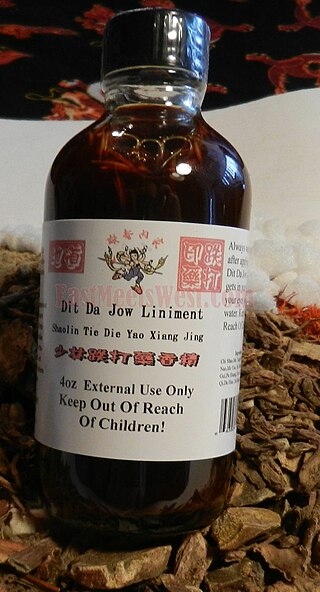
Dit da jow is a common Chinese liniment used as traditional medicine in the belief it can reduce the pain from external injuries.
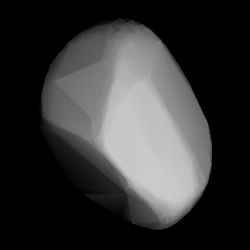
1061 Paeonia, provisional designation 1925 TB, is a carbonaceous background asteroid from the outer regions of the asteroid belt, approximately 19 km (12 mi) in diameter. It was discovered on 10 October 1925, by German astronomer Karl Reinmuth at the Heidelberg-Königstuhl State Observatory in Heidelberg, Germany. The C-type asteroid has a rotation period of 8 hours and is likely very elongated. It was named after the flowering plant Paeonia, commonly known as peony.

The Kanagawa Prefectural Ofuna Botanical Garden is a botanical garden located at 1018 Okamoto, Kamakura, Kanagawa, Japan. It is open daily except Mondays; an admission fee is charged.
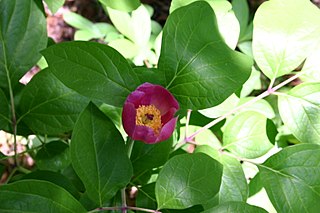
Paeonia obovata is a perennial herbaceous species of peony growing 30–70 cm high. It has white, pink or purple-red flowers and its lower leaves consist of no more than nine leaflets or segments. In English it is sometimes called woodland peony. It grows naturally in warm-temperate to cold China, including Manchuria, and in Korea, Japan, Far Eastern Russia and on Sakhalin.

Anthoxanthins are a type of flavonoid pigments in plants. Anthoxanthins are water-soluble pigments which range in color from white or colorless to a creamy to yellow, often on petals of flowers. These pigments are generally whiter in an acid medium and yellowed in an alkaline medium. They are very susceptible to color changes with minerals and metal ions, similar to anthocyanins.
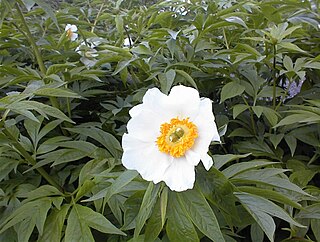
Paeonia emodi is a robust herbaceous perennial plant that winters with buds underground, has large white flowers and large deeply incised leaves, and belongs to the family Paeoniaceae. Its local vernacular names include mamekhor or mamekh (Punjabi), ood-e-saleeb (Urdu) meaning "with-a-cross", ood salap (Hindi), mid and 多花芍药 meaning "multi-flower peony". In English it is sometimes called Himalayan peony. It is among the tallest of the herbaceous peony species, and, while cold-hardy, it grows better in warm temperate climates. It is a parent of the popular hybrid 'White Innocence', which reaches 1½ m.
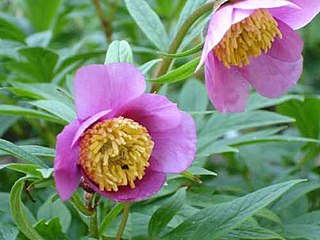
Paeonia veitchii is a species of herbaceous perennial peony. The vernacular name in China is 川赤芍. This species is ½-1 m high, has a thick irregular taproot and thin side roots, and deeply incised leaves, with leaflets themselves divided in fine segments. It has two to four fully developed flowers per stem, that may be pink to magenta-red or rarely almost white. It is known from central China.

Paeonia × suffruticosa is a name used for a group of cultivars of tree peonies that are the result of hybridisation with species exclusively belonging to the subsection Vaginatae. The common name used in China is mǔdān. Plants belonging to this group have been cultivated for millennia in China, initially only as a source of traditional Chinese medicine particularly the skin of its roots. Already early on the plant was also cultivated for its ornamental value, and it is highly revered in Chinese culture.

ε-Viniferin is a naturally occurring phenol, belonging to the stilbenoids family. It is a resveratrol dimer.
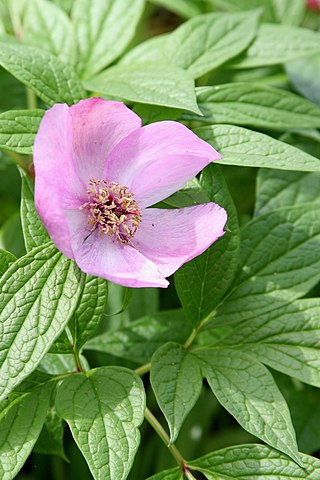
Paeonia mairei is a species of peony, that is endemic to the mountains of central China. Its vernacular name in China is 美丽芍药 meaning "beautiful peony". The plant may be between 45 and 100 cm high and has mostly rose-pink flowers of about 10 cm across, one on each stem. P. mairei blooms in early spring.
Paeonia sterniana is a perennial, herbaceous peony of approximately 45 cm high in cultivation, with white or sometimes pinkish flowers. It grows in the wild in southeastern Tibet. This peony is very rare in cultivation. It produces blue seeds in autumn. Its common name in Chinese is 白花芍药, which means "white peony".

Paeonia tenuifolia is a herbaceous species of peony that is called the steppe peony or the fern leaf peony. It is native to the Caucasus Mountains, with large fields found in Vashlivani National Park in Georgia and the Black Sea coast of Ukraine, spreading westward into Bulgaria, Romania and Serbia and eastward to northwestern Kazakhstan. It was described by Linnaeus in 1759. The leaves are finely divided into almost thread-like segments and grow close together on the stems. This peony can reach 30–60 cm (12–24 in) in height. The scented red flowers have numerous yellow stamens in the centre.

Paeonia anomala is a species of herbaceous perennial flowering plant in the family Paeoniaceae. This peony is ½-1 m high, with a thick irregular taproot and thin side roots. The deeply incised leaves have leaflets which are themselves divided in fine segments. It flowers in early summer, almost always with only one fully developed flower per stem, magenta-red or rarely pink or white. The species occurs in a zone between northern European Russia and northern Mongolia and south to the Tien Shan Mountains.

1,3,6-Trigalloyl glucose is a gallotannin. It can be found in Paeonia lactiflora and Terminalia chebula.

Paeoniflorin is a chemical compound which is one of the major constituents of an herbal medicine derived from Paeonia lactiflora. It can also be isolated from the fresh water fern Salvinia molesta.
P. albiflora may refer to:

















